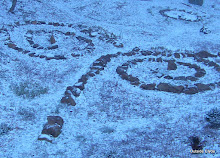The hand mowing of the dead dried sticks of the perennials was pretty much completed today. A garden such as it is emerges once again from the Lush that swallows it up in the time of vegetation.

A garden such as it is was planted directly into the wild forest. Little was disturbed in the process. The planting was done around things. The wild and the cultivated merge into one, forming a unique take on the notion of what a garden is and should be.

This is the wild cultivated garden, freshly hand mowed and ready for the emergence of 10,000 daffodils and an equal or greater number of minor bulbs to start things off. As the vegetation builds, the bulbs will be followed by the emergence of an assortment of herbaceous perennial, biennial and annual flowering and foliage plants too numerous to count. The shrubs will slowly be engulfed by the exuberant chaos. The wildness will dominate once more.
This is gardening on the edge of wilderness.

It should be no surprise then that the wild cultivated garden sits on the edge of another line. I tried out the interactive feature of the new USDA Plant Hardiness Zone map to see what they had to say about the low spot on a North Carolina mountain top.
There we are inside that oval. The gardens boundaries marked by the two red lines, the scenic byway and the county line. There we are sitting right on the edge of a zone 6a and 6b. And just to make things special there is a zone 5b just down the road a ways.
According to this map the cozy cabin is in a different climate zone than the resident gardeners house next door.

This is a garden on the edge.

Yesterday morning before the rains stopped, it decided to spit snow and other forms of frozen precipitation. A brief round of needed cold has arrived that will help slow the onset of spring. I drove to town the same morning. Down there the sun was out, the wind was calm, it was rather balmy. I drove back home and reentered the clouds.

This is the wild cultivated garden on the low spot of a North Carolina mountain top where we garden on the edge of so many things.






9 comments:
I choose to view your 'aina as being at the leading edge of something wonderful. It most definitely is not at the end of the line!
It is hard for me to tell since they did not put the minor roads on here, but looks like I am 6b and probably has some 6a on the property. My house is at about 2000 ft. I have crocus and daffodils blooming right now. My flowering quince is partially in bloom and the forsythia is trying to get into the action with a single bloom here and there. But tonight is going to be cold, so hopefully the fruit trees will wait.
It will be interesting to see what your plants think of the new USDA hardiness map...if they even notice.
Pomaika'i the leading edge is good.
Wow Dianne. It sounds like you are a month ahead of schedule and ahead of me big time. I may have seen the first tiny tip of the first of hundreds of crocus coming up. More daffodils popping up all the time, but I expect that now.
Ha ha Garden Broad. The only plants that may notice are those rated to zone 6. I felt like I was pushing my zone boundaries with them and tried to get at least zone 5 rated plants. This year I am having a zone 7 winter. Could go back to zone 5 on a moments notice.
That is on the edge. With your wild garden, you would appreciate the gardens of Carl Krippendorf, who was a friend of Eliz. Lawrence. He was in Cinncinati, she in Charlotte, NC. He planted a lot of daffodils, and other bulbs in his woods, but left it for the most part wild.
Carol I remember that post about Carl Krippendorf. I should research him.
I failed to say that all my bloomers are in "hollers" or micro climates here. Most of the blooms are in the old homestead holler where there is a spring and small stream. The other area where the daffodils are blooming big time is at the bottom of a hill by a stream. Nothing is happening up here on the mountain where are house is.
How about "our" house. My fingers have no brains.
Post a Comment